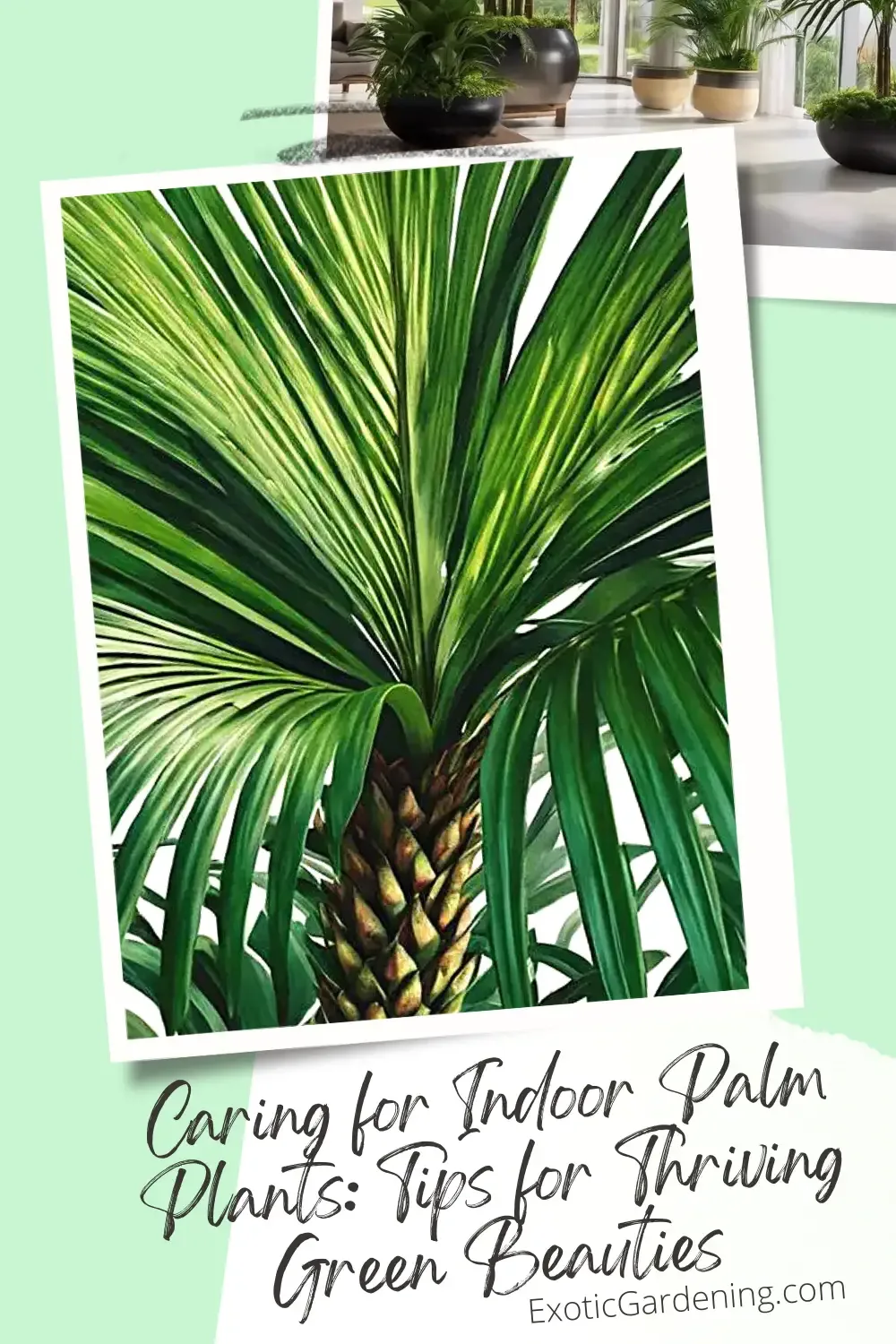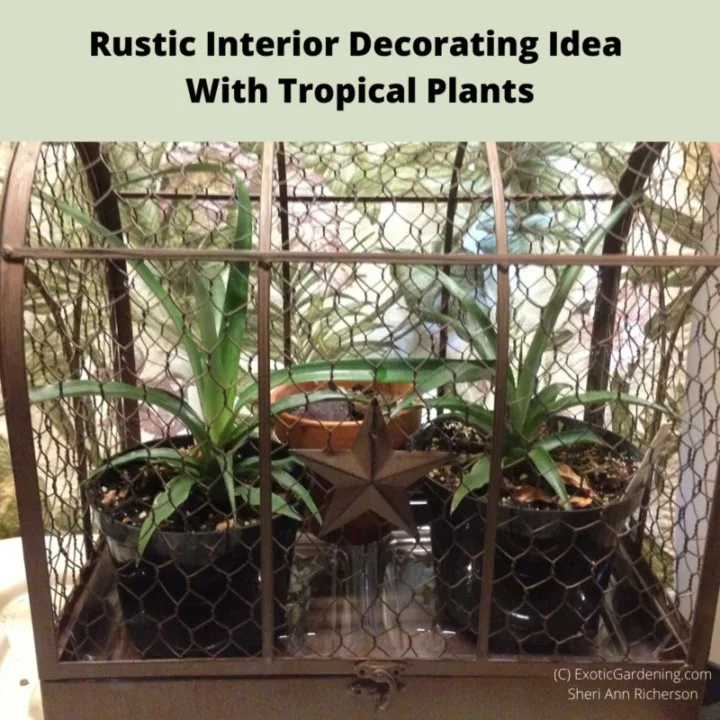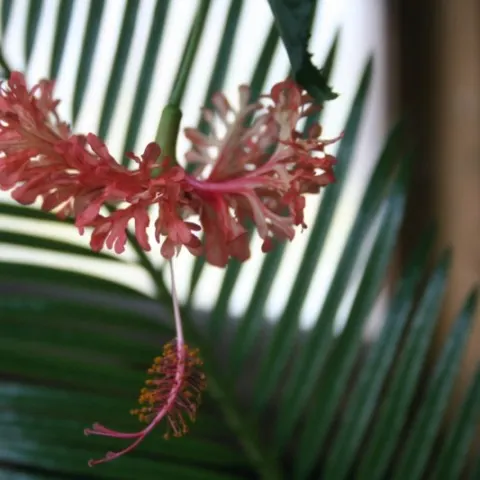Caring for indoor palm plants, including popular varieties like the areca palm, majesty palm, and parlor palm, is an art that goes beyond mere aesthetics.
These botanical companions not only add a serene allure to your living space but also demand thoughtful consideration for their well-being.
Let's dive into the heart of this lush green adventure, exploring the specific needs of each palm variety.
From their light preferences to ideal temperatures and humidity levels, understanding their needs lays the foundation for a thriving indoor oasis.
And as any plant enthusiast knows, watering and fertilizing are pivotal rituals in the care routine, with details that can spell the difference between a flourishing palm and one that falters.
But it's not just about the nurturing aspects.
We'll also embark on a journey through the potential pitfalls—those pesky pests and diseases that threaten our green companions.
Fear not, for armed with knowledge, we'll explore preventive measures and effective treatments, ensuring that your indoor palm not only survives but flourishes, radiating health, happiness, and tropical vibes throughout your homestead.
So, let's nurture those indoor palms together and create a thriving oasis right in the heart of your home!
Understanding Your Indoor Palm
Getting to know your indoor palm plants is like stepping into a captivating universe for plant enthusiasts.
The allure of indoor palms extends beyond their visual appeal, with the added benefits of tropical vibes and air purification.
Yet, much like any plant, each type of indoor palm demands specific care to truly thrive.
So, let's unravel the intricacies and spotlight some indoor palm varieties that crave that extra bit of attention.
- Majesty Palm (Ravenea rivularis): Appearance: Majestic and regal, this palm graces any indoor garden with its beauty. Care Tips: Enjoys bright, indirect light and thrives in a consistently humid environment. Keep the soil moist and consider a pebble tray water system for optimal health.
- Parlor Palm (Chamaedorea elegans): Appearance: A petite and hardy palm, perfect for indoor settings. Care Tips: Watch for brown leaf tips, a sign of under-watering. Keep the soil consistently moist, provide bright, indirect light, and the occasional misting to maintain humidity.
- Cat Palm (Chamaedorea cataractarum): Appearance: Majestic and eye-catching, the Cat Palm adds a burst of greenery. Care Tips: Demands ample bright light and high humidity. Ensure uniform watering and protect from drafts for optimal growth.
- Areca Palm (Dypsis lutescens): Appearance: Delicate and feathery, the Areca Palm, or Butterfly Palm, is a fast-growing beauty. Care Tips: Thrives in bright, indirect light. Requires generous watering in spring and summer, scaling back in autumn and winter. Watch for pests like mealybugs and spider mites.
These are just a few examples of indoor palm plants that appreciate a little extra tender loving care, and the effort invested brings forth abundant rewards for both your living space and personal well-being.
So, it's time to grab that watering can, roll up your sleeves, and embark on the fulfilling journey of indoor palm care.
Remember, a trusty thermometer and hygrometer are your allies in mastering the indoor tropical environment.
Let the Light In: Navigating Indoor Palm Illumination
Understanding the specific light requirements of your indoor palm is akin to finding the perfect spot in the sun – or shade – for a dear friend.
Each palm species has its unique preference when it comes to lighting, and getting this aspect right is pivotal for their overall health and vitality.
Diverse Light Preferences
Palms, like individuals, have their own personalities, and this extends to their light preferences.
Some thrive in the spotlight of bright, indirect light, soaking up the energy without the harshness of direct sun exposure.
Majestic palms, for instance, often fall into this category, basking in the gentle glow that mimics their native habitats.
On the other hand, there are palms that are a bit more introverted, capable of tolerating lower light conditions.
These species, like the adaptable cast iron plant or parlor palm, bring a touch of greenery to corners where sunlight might be more subdued.
The Dance of Placement
Proper placement within your home is a choreography that can significantly impact the well-being of your indoor palms.
Placing a light-loving palm in a shadowy corner or subjecting a low-light tolerant palm to constant, intense sunlight is like asking them to dance to a tune that doesn't suit their style.
For palms that crave brightness, consider positioning them near windows with filtered sunlight or in well-lit areas of your home.
These areas mimic the dappled light of their natural environments, fostering a sense of familiarity and promoting healthy growth.
For those that prefer a more subdued ambiance, spaces with lower light levels, away from the direct rays of the sun, are ideal.
These corners can be transformed into lush retreats where your palms can thrive without feeling overwhelmed.
By understanding the unique needs of your green companions, you can curate a stage that accentuates their strengths and sets the scene for a flourishing, harmonious dance between light and leaves.
Watering and Fertilizing Indoor Palms
Embarking on the journey of indoor palm care is akin to a partnership—a dance with nature where you and your plants learn and grow together.
Amidst the beauty they bring to your home, mastering the art of watering and fertilizing becomes a pivotal factor in ensuring their overall health and visual allure.
Yet, a one-size-fits-all approach to watering and fertilizing indoor palms, such as the Majesty Palm, Parlor Palm, Cat Palm, and Areca Palm, isn't precise.
Each type has its unique care requirements, but there's a general guide to help your palms thrive.
- Watering Wisdom: Maintaining balance is key to their prosperity. Indoor palms thrive in a well-hydrated but not waterlogged or dry environment. Aim for frequent, light watering rather than occasional soaking, adjusting frequency based on your home's humidity. A helpful tip: when the top inch of soil is dry, it's time to water. Exercise caution to avoid overwatering-induced root rot or underwatering resulting in brown, crispy leaves.
- Fertilizer Feast: Feeding your palms every two to three months during their growing season (April to September) ensures a nutrient-rich diet. Opt for a slow-release granular fertilizer with a nitrogen-phosphorous-potassium ratio of 3:1:3 or 15:5:15. This blend sustains vibrant green hues and promotes robust growth. Skip fertilizing in winter, their resting period, and always moisten the soil before fertilizing to prevent root burn.
Indoor palm plants are more than mere houseplants; they symbolize patience, love for nature, and a connection to the outdoors.
As they flourish and illuminate your living space, share the joy of indoor gardening.
Witnessing the fruits of your labor thrive brings unparalleled joy.
With a mindful watering and fertilization routine, your palms will flourish, turning your indoor space into a thriving jungle of green delight.
Nurturing Indoor Palms with Humidity Management
In the world of indoor palms, creating a tropical haven isn't just about light and water—it's also about mastering the art of humidity management.
Many of these green companions hail from lush tropical regions where humidity is as abundant as the vibrant foliage.
Understanding and replicating this humidity-rich environment in your home can be a game-changer for the well-being of your indoor palms.
Tropical Origins and High Humidity
Picture the dense rainforests or palm-lined beaches – these are the native habitats of many indoor palms.
In these tropical paradises, high humidity is a constant companion, providing the perfect backdrop for palms to thrive.
The air is rich with moisture, a crucial element for their growth and vitality.
Importance of Humidity for Indoor Palms
When you bring these tropical beauties into your home, it's essential to recognize their affinity for humidity.
Indoor environments, especially during the drier months or in homes with central heating, can often lack the moisture levels that palms naturally adore.
Without adequate humidity, indoor palms may show signs of stress, such as dry leaf tips or browning.
Tips for Effective Humidity Management:
- Misting: Give your indoor palms a refreshing misting, especially during drier periods. This simple act mimics the fine droplets of tropical rain, providing a moisture boost.
- Pebble Trays: Place water-filled pebble trays near your palms. As the water evaporates, it enhances the immediate surrounding humidity, creating a microclimate that mirrors their native habitat.
- Grouping Plants: Arrange indoor plants, including palms, in clusters. As they transpire, releasing moisture into the air, the collective effect contributes to a more humid environment.
- Use a Humidifier: Investing in a humidifier is a proactive step, especially in areas with consistently low humidity. This device can maintain optimal moisture levels, benefitting not only your palms but other indoor plants and your own comfort.
By paying attention to humidity management, you're not just caring for indoor palms; you're creating a tropical sanctuary within your home.
The air becomes a symphony of moisture, reminiscent of the palm's native lands, and your green companions respond with vibrant, healthy foliage.
Pest Management and Disease Prevention for Indoor Palms
Diving into the realm of indoor palm care extends beyond the basics of water, sunlight, and fertilization.
It's about safeguarding your tropical companions from common pests and diseases that lurk in the shadows, ready to challenge the well-being of your beloved palms.
So, let's unravel the mysteries and learn how to manage these intruders effectively.
Dealing with Pests
Meet the notorious duo – spider mites and scale, common troublemakers for indoor palms.
Spider mites, those tiny web-spinning menaces, thrive in dry conditions.
Combat them by maintaining humidity through occasional misting.
For existing infestations, turn to insecticidal soap or neem oil treatments.
On the flip side, scale insects form bumpy brown or tan structures, sapping nutrients and causing wilting.
Introduce natural predators like ladybugs or lacewings, or in severe cases, apply horticultural oil.
If you spot stickiness beneath your palm, it's a telltale sign of a lurking scale infestation.
Navigating Diseases
Fungal leaf spots can cast a shadow on your palm's beauty, marked by discolored patches.
Ensure proper ventilation and avoid overwatering to prevent these spots.
Prune affected leaves and use a suitable fungicide for effective treatment.
Root rot, a sneaky waterlogged soil disease, induces wilting and yellowing.
Prevention involves well-draining soil and avoiding overwatering.
If affected, reduce watering immediately and consider repotting in fresh, well-draining soil.
Fusarium wilt brings one-sided discoloration, wilting, and eventual demise.
Prevention includes sterilizing shears before pruning and steering clear of overwatering.
Stay Vigilant
Regular inspections are your best defense.
Early detection can be the savior of a healthy palm.
Palms are resilient; armed with knowledge, they can overcome most challenges.
So, continue immersing yourself in the captivating world of indoor palm gardening.
With care and attention, your tropical oasis will thrive, transforming challenges into opportunities for growth.
Navigating Indoor Palm Care: From Natural Habits to Potential Pitfalls
The issue with watering indoor palm trees often arises from the difference between their native habitats and the confined indoor environment.
Unlike their natural counterparts exposed to rainfall, indoor palms face the constraints of pots, lacking the innate drainage of soil in the ground.
This can lead to water accumulation, posing risks like root rot.
To emulate the natural watering process, ensure pots have proper drainage, allowing excess water to escape.
Tips for Watering Indoor Palms
When watering indoor palms, a crucial practice involves thorough watering, allowing excess water to drain away.
Additionally, it's vital to let the top inch of the soil dry before the next watering, preventing the common woe of overwatering.
Addressing Salt Accumulation Concerns
Salt buildup in potting soil is a genuine worry for indoor palms, particularly when tap water or high-salt fertilizers are used.
The ramifications include hindered water absorption, root damage, and leaf browning.
Mitigating this issue involves practical steps:
- Use Distilled or Collected Rainwater: Opt for distilled or rainwater, which are lower in salts compared to tap water.
- Flush the Soil: Periodically flush the soil with ample water to leach out accumulated salts, ensuring proper drainage.
- Choose Low-Salt Fertilizers: Select fertilizers tailored for indoor plants and palms with lower salt content.
- Monitor Soil pH: Check the soil pH regularly as salt accumulation can contribute to acidification. Adjust the pH if needed for optimal nutrient availability.
By prioritizing water quality, choosing suitable fertilizers, and periodic soil flushing, you safeguard your indoor palm from potential pitfalls.
This mindful approach ensures the longevity and well-being of your green companion, fostering a thriving urban jungle oasis in your living space.
The Art of Pruning and Grooming Indoor Palms
In the rhythmic dance of indoor palm care, pruning and grooming take center stage as the choreography that shapes the elegance of these green companions.
Much like a skilled gardener tends to a masterpiece, understanding the nuances of proper pruning is essential to not only maintain the palm's form but also to foster a thriving environment for new growth.
The Purpose of Pruning
At its essence, pruning serves as a form of botanical self-care for indoor palms.
It involves the selective removal of dead or damaged fronds, keeping the plant tidy and allowing energy to be redirected toward healthy, new growth.
This not only enhances the aesthetic appeal of the palm but also contributes to its overall well-being.
Essentials of Proper Pruning:
- Identify Dead or Damaged Fronds: Regularly inspect your indoor palm for any fronds that have withered, turned brown, or suffered damage. These are the prime candidates for removal.
- Use Clean, Sharp Tools: Employ sharp, clean pruning shears to make precise cuts. This minimizes the risk of tearing or injuring the remaining foliage.
- Cut at the Base: When removing a frond, cut it at the base, close to the main trunk. Avoid leaving stubs, as they can become entry points for pests or diseases.
- Mindful Grooming: Beyond pruning, gentle grooming involves the removal of dust or dirt that may accumulate on the leaves. Wipe the fronds with a damp, soft cloth to keep them clean and allow for better light absorption.
Proper pruning and grooming go beyond aesthetics; they play a crucial role in the overall health of your indoor palm.
By removing dead or diseased foliage, you not only prevent the spread of potential issues but also encourage the plant to allocate resources to new, vibrant growth.
Growing Your Green Family: A Guide to Indoor Palm Propagation
For plant enthusiasts with a passion for expanding their indoor jungle, delving into the art of propagation opens a gateway to a world of new possibilities.
Understanding the propagation techniques for indoor palms, whether through seed germination or offshoot division, is a rewarding and fulfilling aspect of caring for these verdant companions.
Seed Germination:
- Seed Selection: Begin with high-quality seeds from a reputable source. Palms produce seeds in abundance, and each species may have unique characteristics.
- Preparation of Growing Medium: Create a suitable growing medium by combining well-draining soil with a touch of organic matter. The goal is to mimic the palm's natural habitat.
- Planting Seeds: Gently plant the seeds at a shallow depth in the soil. Keep them consistently moist, covering the container with plastic to create a mini-greenhouse effect.
- Patience and Care: Seed germination requires patience. Regularly monitor moisture levels and provide adequate light. As the seedlings emerge, gradually acclimate them to their new environment.
Offshoot Division:
- Identifying Offshoots: Palms often produce offshoots or "pups" at the base of the main plant. These are genetically identical to the parent and can be carefully separated to create new plants.
- Preparation for Division: Before dividing, ensure that the offshoot has developed sufficient roots of its own. This is an indication that it can sustain itself as an independent plant.
- Gentle Separation: With clean, sharp tools, carefully separate the offshoot from the parent plant. Be mindful not to damage the roots during this process.
- Potting and Care: Transplant the offshoot into a suitable pot with well-draining soil. Provide the same care as you would for a mature indoor palm, gradually adjusting it to its new environment.
Embarking on the journey of indoor palm propagation offers not only a tangible expansion of your green family but also a deeper connection to the lifecycle of these remarkable plants.
Whether coaxing seeds into vibrant seedlings or carefully nurturing offshoots into independent plants, the propagation process becomes a nurturing dance between caretaker and green life.
As you explore the rewarding realm of propagation, remember that each new palm is a testament to your dedication and a unique addition to your indoor oasis.
Embrace the process with patience and joy, and watch as your collection grows, becoming a living testament to the beauty of nature's continuous cycle.
Unveiling the Essentials of Indoor Palm Care
As we delve deeper into the captivating world of indoor palms, a profound realization takes root – knowledge, attentiveness, and patience stand as the pillars of their care.
This revelation unfolds through the delicate dance of monitoring and adjusting light, temperature, and humidity, coupled with crafting a meticulous watering and fertilization rhythm.
Yet, the journey doesn't end there.
Remaining vigilant against potential threats, be they pesky pests or lurking diseases, emerges as a crucial act to safeguard the health and longevity of your indoor palms.
So, before you find yourself immersed in the lush foliage of your local plant emporium, captivated by the towering elegance of a palm, let this be your guiding light: the secrets to its happiness lie in understanding its distinct needs and providing unwavering care and protection.
Embrace these fundamental principles, and stand witness as your indoor palms reciprocate with lush beauty and serene grace, transforming your space into an urban jungle oasis that's as vibrant as it is tranquil.
Palms in the Living Room: Your Ultimate FAQ
Q: Can I grow any type of palm tree indoors?
A: While many palm varieties can thrive indoors, some are better suited than others. Look for smaller, slow-growing species like the Areca palm or the Parlor palm for optimal indoor conditions.
Q: How much light do indoor palm trees need?
A: Palms generally prefer bright, indirect light. Place your indoor palms near a window with filtered sunlight, and rotate them occasionally for even growth.
Q: What's the right soil mix for indoor palms?
A: Well-draining potting mix is crucial. A mix of peat, perlite, and pine bark works well. Ensure the pot has drainage holes to prevent waterlogged soil.
Q: How often should I water my indoor palm?
A: Palms like their soil consistently moist but not soggy. Water when the top inch of soil feels dry, adjusting based on your home's humidity levels.
Q: Do indoor palms need fertilizer?
A: Yes, but sparingly. Use a balanced liquid fertilizer during the growing season, typically spring and summer. Dilute it to half strength to avoid overfeeding.
Q: Can I prune my indoor palm tree?
A: Yes, remove yellowing or damaged fronds with clean, sharp scissors. Avoid cutting into the green, healthy parts of the fronds.
Q: Do indoor palms suffer from pests?
A: Spider mites and scale insects can be an issue. Keep an eye out for webs or sticky residue on leaves. Regularly inspect and treat with insecticidal soap if needed.
Q: Should I repot my indoor palm?
A: Repot when the plant outgrows its container or if you notice roots emerging from the drainage holes. Every 2-3 years is a good general guideline.
Q: Can I place my indoor palm outside during summer?
A: Yes, many palms enjoy a summer vacation outdoors. Gradually acclimate them to the outdoor conditions, starting with a few hours of morning sunlight.
Q: What about humidity for indoor palms?
A: Palms appreciate higher humidity levels. You can mist the leaves or place a tray of water near the plant to increase moisture in the air.
Q: Are indoor palms prone to diseases?
A: Overwatering can lead to root rot, a common issue. Ensure proper drainage and let the soil dry out slightly between waterings to prevent this.
Q: Can I grow a palm tree from seeds indoors?
A: Absolutely! While it requires patience, you can grow palms from seeds. Ensure the seeds are fresh, and provide warmth and consistent moisture for germination.
Q: How can I revive a struggling indoor palm?
A: Assess the watering routine, check for pests, and ensure proper light. Trim away any dead or yellowing fronds and consider repotting if the root system seems crowded.
Q: Are there any toxic palms for pets?
A: Some palms, like the Sago palm, can be toxic to pets. Choose pet-friendly varieties if you have furry friends at home.
Tropical Fruit And Foliage Plants
Tropical Plants For Medium To High Light
Check out these awesome tropcial plants for medium to high light that make wonderful, easy to care for houseplants.
How To Grow Cinnamon
Learn how to grow cinnamon from seed or cuttings. Cinnamon trees do well as houseplants even though they can get rather large.
How To Grow And Harvest Pineapple From Home
Learning how to grow and harvest pineapple is a fun project that anyone in any climate can experience as long as they are patient.
Colorful Foliage Plants
Try these colorful foliage plants in your garden this summer and then bring them indoors during the winter to brighten up your home decor.
Easy Exotic Houseplants: Tropicals That Thrive Indoors in Containers
Tropical plants are the most beautiful, easy to grow indoor houseplants. Start growing exotic houseplants today that fruit and flower!
Eucalyptus Growing Indoors: Tips and Troubleshooting Guide
Discover the art of eucalyptus growing indoors for year-round beauty and fragrant cut foliage in your flower arrangements.
My Theobroma cacao Story
I've had a love affair with growing chocolate for over twenty years, so I wanted to share my Theobroma cacao story with all of you.
Scented Grass Adds Natural Fragrance To The Home Or Garden
Scented grass is one way to add scent to your garden or even your home. Best of all, they look pretty, smell great and have practical uses.
Learning About Bananas
Once you start learning about bananas you may find this popular and important fruit is really quite fascinating and makes a great houseplant.
The Enigmatic Elegance: A Comprehensive Guide to Philodendron Florida Ghost Care
Elevate your indoor gardening with our guide to Philodendron Florida Ghost care, propagation, and maintenance tips.
Incorporating Bold And Exotic Plants Into Your Landscape
Discover the allure of bold and exotic plants for your garden in this comprehensive guide. Transform your landscape today!
Variegated And Other Interesting Plants: Elevate Your Space with Nature's Painted Wonders
Explore the world of variegated and unique plants, adding vibrant beauty and intrigue to your indoor oasis.
How To Grow Tropical Plants
Growing tropical plants - also known as houseplants - indoors is fun and enjoyable plus many of them clean the indoor of pollutants.
It is easy to grow exotic looking plants that produce tropical fruit and colorful flowers in a pot in your living room or office.
Many of these plants are easy to start from seed and I share with you five plants that I recommend for indoor growing.
I also share with you why growing your own tropical fruit saves money.
In this video you will learn:
How to bring tropical plants indoors at the end of summer
How to grow tropical plants indoors
How to protect and overwinter tropical plants outdoors in cold climates
How to propagate tropical plants
How to water tropcial plants
How to grow topical plants in a greenhouse
















